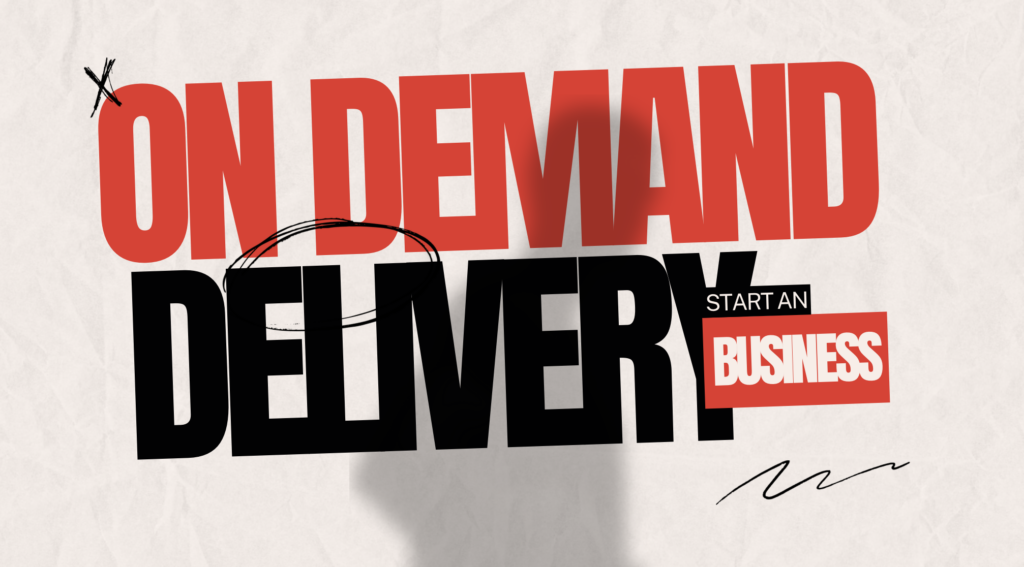
Start an On Demand Delivery Business.

The on-demand delivery market is booming, driven by consumers’ desire for convenience and speed. From food and groceries to pharmaceuticals and retail products, the demand for fast, reliable delivery services is higher than ever. If you’re considering starting your own on-demand delivery business, this guide will help you navigate the process, from initial planning to scaling your operations.
Understanding the On-Demand Delivery Market
Before diving into the logistics of starting your business, it’s crucial to understand the market landscape. On-demand delivery services have become an integral part of daily life for many, providing a valuable solution for busy individuals and businesses alike. Key trends driving this market include:
• Increased consumer demand for convenience: People want quick and easy access to products without leaving their homes.
• Technological advancements: The proliferation of smartphones and delivery apps has made it easier for businesses to connect with customers.
• Diverse service offerings: From meal delivery to last-mile logistics, there are numerous niches to explore.
Step 1: Conducting Market Research
Market research is the foundation of any successful business. It helps you understand your target audience, identify competitors, and find your unique value proposition. Here’s how to get started:
• Analyze the competitive landscape: Identify existing players in your chosen niche and evaluate their strengths and weaknesses.
• Identify your target audience: Determine who your potential customers are, their needs, and their preferences.
• Use market research tools: Utilize surveys, focus groups, and online tools to gather data and insights.
Step 2: Creating a Solid Business Plan
A well-crafted business plan is essential for guiding your business strategy and securing funding. Key components of your business plan should include:
• Executive summary: A brief overview of your business concept and goals.
• Market analysis: Insights from your market research, including target audience and competitive landscape.
• Business model: Outline your service offerings, pricing strategy, and revenue streams.
• Operational plan: Detailed plans for logistics, delivery management, and customer service.
• Financial projections: Budgeting, cash flow analysis, and funding requirements.
Step 3: Navigating Legal and Regulatory Requirements
Ensuring your business complies with legal and regulatory requirements is critical. Here are some steps to follow:
• Register your business: Choose a business name and legal structure (e.g., sole proprietorship, LLC) and register with the appropriate authorities.
• Obtain necessary licenses and permits: Research the specific licenses and permits required for your type of delivery service.
• Understand zoning laws and regulations: Ensure your operations comply with local zoning laws and delivery regulations.
Step 4: Building Your Technology Stack
Technology is at the heart of any on-demand delivery business. Here’s what you need to consider:
• Delivery management system: Choose a platform that offers route optimization, real-time tracking, and efficient order management.
• Mobile app: Develop a user-friendly app for customers to place orders and track deliveries. Consider hiring developers or using off-the-shelf solutions.
• Payment integration: Integrate secure payment gateways to facilitate smooth transactions.
Step 5: Setting Up Delivery Operations
Efficient delivery operations are crucial for customer satisfaction. Key aspects include:
• Building a fleet: Decide whether to use in-house drivers or partner with third-party delivery services.
• Managing logistics: Implement systems for route optimization, real-time tracking, and delivery scheduling.
• Ensuring quality control: Establish protocols for handling orders, managing delays, and addressing customer complaints.
Step 6: Marketing and Customer Acquisition
To attract and retain customers, you need a robust marketing strategy. Consider the following tactics:
• Digital marketing: Leverage SEO, PPC, social media, and email marketing to reach your target audience.
• Offline marketing: Utilize flyers, local events, and partnerships to build brand awareness.
• Customer engagement: Implement loyalty programs, referral incentives, and personalized offers to keep customers coming back.
Step 7: Scaling Your Business
Once your business is up and running, focus on scaling and growth. Here are some strategies:
• Expand to new markets: Identify new geographic areas or niches to serve.
• Streamline operations: Use automation and technology to improve efficiency and reduce costs.
• Manage finances: Keep a close eye on cash flow, explore funding options, and consider pitching to investors for growth capital.
Real-World Case Studies and Insights
Learning from the success and challenges of others can provide valuable insights. Analyze case studies of top on-demand delivery businesses to understand best practices and common pitfalls. Engage with industry experts through webinars, Q&A sessions, and networking events to gain deeper knowledge.
Conclusion
Starting an on-demand delivery business requires careful planning, strategic thinking, and a commitment to excellence. By following this step-by-step guide, you’ll be well-equipped to navigate the complexities of the industry and build a thriving business. Stay focused on your goals, continually adapt to market changes, and prioritize customer satisfaction to achieve long-term success.
For more detailed insights and practical guidance, consider enrolling in our comprehensive course, “Mastering On-Demand Delivery: Launch Your Own Business from Scratch.” This course offers expert-led modules, interactive workshops, and real-world projects to help you turn your entrepreneurial vision into reality.
Ready to get started? Your on-demand delivery empire awaits!
